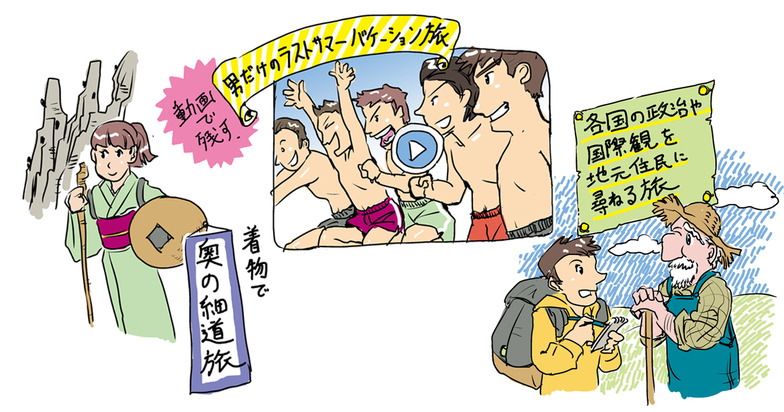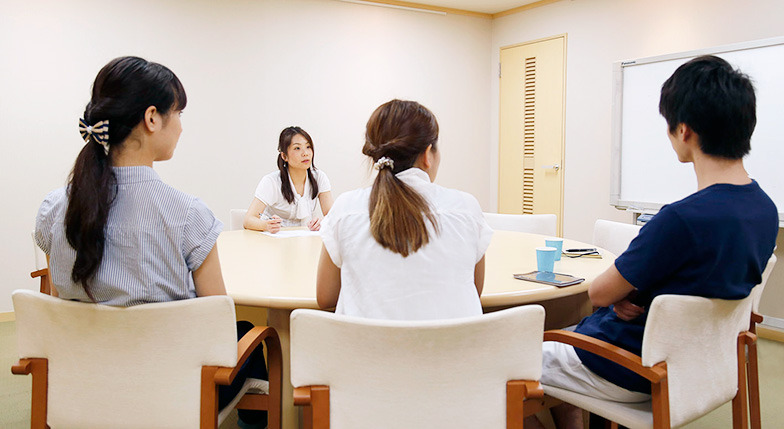"Travel while you're a college student with plenty of time."
Haven't most of us either said this or heard it ourselves?
Now, the roughly two-month summer break for such university students is nearing its end.
What kind of trips are today's college students taking?
According to the 2015 Dentsu Inc. Youth Survey, 34.5% of male college students ranked "Domestic Travel" as their favorite activity, placing it 9th out of 68 items (among female college students, it ranked 8th at 42.8%).
Compared to other items, "travel" consistently ranks high in college students' favorite activities.
In terms of spending, domestic travel ranked #1 at ¥101,846 per year, while overseas travel ranked #1 at ¥290,843 per year. Considering the average monthly disposable income for university students is ¥36,514, the amount spent on travel appears relatively high.
As someone who loved to travel and felt restless every summer during my university days, I decided to explore the travel habits of today's youth.
Aimless wandering trips are a no-go! Opt for "concept-driven travel" you can only do now
This time, we asked four male and female university juniors and seniors about their summer vacation travel plans.
Contrary to expectations, these were the responses:
"I do go overseas for volunteer work, but it doesn't feel like a trip purely for fun."
(Female University Student A, Year 3)
"I have corporate internship camps and club retreats too. If you count those as trips, I'll be going about three times this summer."
(University Senior B)
As we listened to their stories, it seems that while "purely recreational trips" do exist, training camps and internships make up about half of their travel.
So-called aimless wanderings seem to be in the minority; trips with a clear "purpose or concept" are apparently more common. When asked specifically what kind of trips they took, the content varied widely.
"Recently, just us guys went to Totsukawa Village in Nara Prefecture with the concept 'Last Summer Vacation.' Being students, we couldn't spend much, but we did silly things only possible now and shot some cool videos. Filming was part of the trip's purpose—we edited highlights like jumping into the river and posted them on SNS."
(Male University Senior C)
"I went on a trip titled 'Okinawa Sports Festival & Social Contribution' for my club's training camp. We held a sports festival on an Okinawan beach, then everyone picked up trash in the surrounding area.
It wasn't just a trip; doing volunteer work before heading home made it a much deeper memory."
(University third-year female student D)
Additionally, when I spoke with students from the Kyoto University English Guide Club I belonged to during my student days (most members are travel enthusiasts), they mentioned:
"A 53-night journey along the Tokaido Fifty-Three Stations" (a trip tracing the former post towns of the Tokaido road, staying with people in exchange for helping them)
"The Journey to Melt into Yayoi Kusama" (Wearing polka-dot clothes to see Yayoi Kusama's artworks and the town where she grew up)
"A Journey Asking Local Residents About Their Countries' Politics and International Perspectives"
"Sleeping at Unmanned Stations" (a journey camping overnight at rural, unmanned train stations)
"Journey Along the Narrow Road to the Deep North in Kimono"
He set various concepts based on his own interests and undertook these journeys.
While talking, I sensed a strong desire among them: since they were investing time and money into traveling amidst busy schedules filled with classes, clubs, and part-time jobs, they wanted to travel with their own purpose or concept.
Beyond the unique concepts themselves, did you notice that each trip has a specific "title"?
Instead of vague titles like "Okinawa Trip" or "Art Tour," they're characterized by titles like "Okinawa Grand Sports Festival: Social Contribution" or "A Journey to Melt into Yayoi Kusama," which clearly convey what they did at each destination.

Illustration: Yosuke Kojima (Dentsu Inc., Creative Planning Division 4)
Dentsu Inc. Youth Research Department analyzes that 'Reasonable Consumption' may be a trend in young people's spending habits, not limited to travel.
"Reasonable consumption" does not mean "cheap" in the literal sense, but rather consuming things for which there is a "reason" (justification) to spend one's money and time.
In other words, to influence young people's actions, it's not enough for something to be cheap; there must be a compelling reason or value that justifies spending money and time.
This "reasonable consumption" mindset likely underlies the trend of planning "travel with purpose or concept" and assigning a "travel title" that allows people to talk about their trip.
By defining the trip's concept and naming it, the "reason" for traveling becomes visible, increasing one's sense of justification for spending and taking action.
Furthermore, giving your trip a catchy title seems to offer multiple benefits: it stimulates a sense of camaraderie among your travel companions, boosting excitement; it provides easy conversation topics on social media and with friends during and after the trip, aiding communication; and it allows you to express your identity through the journey. In this way, you can savor the trip two or three times over.
Using Summary Sites and SNS to Gather "Authentic Voices"
Young people are crafting trips with their own unique concepts, but how do they gather information?
As we listened to their stories, it became clear they strategically use different sources depending on their purpose.
First, to grasp the overall picture of their destination, they use magazines and curated "summary sites."
"I start by checking summary sites for 'must-visit tourist spots' and 'great places to eat'. They clearly summarize the basics and are perfect for initial research."
(Male University Senior B)
"With summary sites and web articles, you can gauge how much people resonate with them by the number of RTs (retweets) or favs (favorites), so I also check those ratings for reference."
(Male University Senior C)
For more detailed information, I gather data through official websites, review sites, comparison sites, personal blogs, and social media.
When using personal blogs or SNS, there seem to be search and posting tips.
"When planning a trip to Korea, I search blog sites for 'Korea girls' trip'. Many pages have people around my age writing realistically about travel schedules and recommended spots, making them easy references for actual itineraries."
(University third-year female student A)
"I post on SNS asking, 'Anyone who's been to Nagoya or is from there, tell me about good restaurants!' I get recommendations that way. After all, people who live there or have been know the best spots. Hearing 'firsthand accounts' is reliable and avoids mistakes."
(University Senior Male C)
Furthermore, among members of the aforementioned university English guide club, a popular travel style involves using websites that match travelers with locals offering free home stays worldwide. They spend months traveling, chatting with locals and getting recommendations for places to visit. The real charm lies in experiencing authentic daily life and hearing locals' genuine opinions.
According to the 2015 Dentsu Inc. Youth Survey, the top factor driving university students' consumption intentions was "recommendations from friends knowledgeable about that genre," cited by 72.0% of respondents.
Amidst a flood of information from various sources, today's university students seem to place great importance on gathering credible information that feels "real" and close to "authentic voices." They do this by leveraging tools like word-of-mouth sites, blogs, and social media from people with similar interests and preferences.
This is how they customize and enrich their travel experiences with a personal concept.
What kind of young people are around you?
【Wakamon Profile】
Dentsu Inc. Youth Research Department (nicknamed Wakamon) is a planning team that engages with the real lives and mindsets of young people, primarily high school and college students. By understanding their "now," we seek hints to brighten and invigorate the near future. We foresee the future based on their insights and realize new businesses that foster better relationships between young people and society. Currently, 14 project members are based across our Tokyo headquarters, Kansai branch, and Chubu branch. We also share updates on the Wakamon Facebook page.






